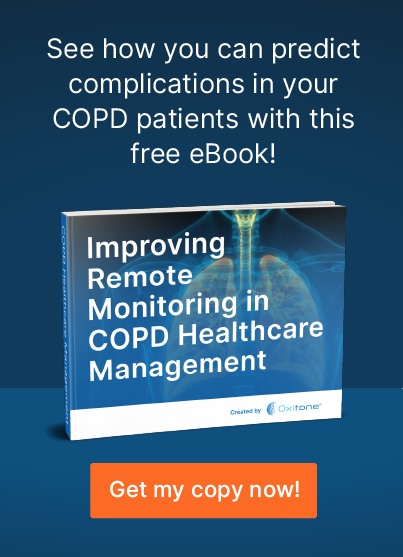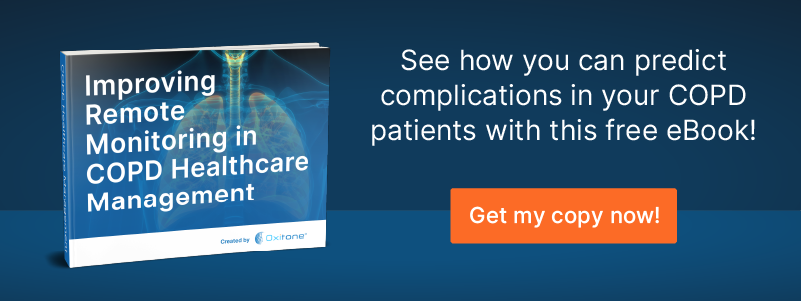The Physical and Emotional Toll of Living with COPD
A diagnosis of chronic obstructive pulmonary disease (COPD) inevitably changes a patient’s life. It means visiting the doctor more often, remembering medications, and living with the fear of worsening conditions, or “flare-ups,” that take a physical and emotional toll on quality of life.
According to the American Lung Association, one of the most challenging things about COPD is that it is just not as easy for patients to do things as before. Simple acts like getting dressed in the morning take longer and lead to fatigue. Patients may not do the things they once loved for fear of a lung flare-up.
Remote patient monitoring (RPM) technology has real-time insights that can take the fear out of daily living, giving doctors and patients immediate access to critical health information to improve COPD monitoring. Conquering the fear of COPD flare-ups leads to improved long-term care, better compliance, and optimal outcomes for patients. By using RPM, doctors can help their patients get back to doing the things that they love.
Remote COPD Monitoring to Detect Flare-Ups Early
COPD flare-ups should be taken seriously. These unexpected exacerbations are the main reason that patients with COPD head to emergency departments for urgent medical care.
Using RPM, we can better detect and even predict when flare-ups will occur. Common triggers, like pollution levels, allergens concentration, and symptoms of respiratory or chest infections, play a role in flare-ups but don’t tell the whole story. A study of 179,759 COD hospitalizations showed that 50% to 75% of all COPD exacerbations were related to chest infections, like colds, flu, and pneumonia. Even more concerning is that once a COPD patient experiences a flare-up related to infection, that patient is at increased risk for flare-ups in the future.
Because a common cold can quickly progress to potentially life-threatening pneumonia in COPD patients, real-time monitoring can improve how we care for patients at risk for flare-ups. This is particularly important in active patients with mild to moderate hypoxia, who may still lead active lifestyles if their disease is well controlled.
Oxitone® Medical Intelligence Enables Prediction—and Action
The unique artificial intelligence-driven system in Oxitone® 1000M allows doctors to make faster decisions for COPD patients by using a comprehensive panel on continuous vital signs in a convenient web-based interface. Not only was Oxitone® 1000M cleared by the FDA, but also, in a blinded study of COPD patients published in the American Journal of Respiratory and Critical Care Medicine, SpO2 measured by the Oxitone® 1000 wearable monitor was shown to be as accurate and precise as traditional COPD monitoring and could be comfortably worn around the clock for continuous monitoring. This offers clinicians the exciting opportunity to get data-driven insights about patients in real time, without the gaps left by traditional monitoring devices. More importantly, the Oxitone® platform turns data into actionable insights.
What sets the Oxitone® 1000 suite apart is its Medical Intelligence system that provides unique opportunities to classify COPD patients by severity and hypoxia level and predict risk status in real time. The system lets doctors manage multiple patients and follow their immediate outcomes and prolonged clinical response to interventions for exacerbations and flare-ups. This is part of a full suite of secured cloud and artificial intelligence tools geared to enable doctors and patients to better manage COPD.
Data Collection Today, Disease Prevention Tomorrow
Each patient is unique, with different lifestyle characteristics, triggers, and severity of COPD. Because so many factors can contribute to flare-ups and unexpected hospitalizations, access to complete and robust COPD monitoring history has the potential to revolutionize COPD care.
Available monitoring systems result in incomplete histories, discontinuous care, and increased expenses. A recent article in the American Journal of Respiratory and Critical Care Medicine stated that to improve COPD care, we critically need access to data about patient exacerbation history and their therapeutic response. With RPM devices to continuously monitor patient vital signs, this critical gap in historical data and response is filled. Doctors can make data-driven decisions for their patients, and patients can rest assured that they have control over their COPD.
To make this vision a reality, Oxitone® offers a full-suite platform for robust and continuous RPM using multiple vital signs. The device enables continuous data collection during the day and at night, so it is available for prevention and for critical care when it is most needed. With just one click, doctors can access patient data in real time with intelligent insights and manage hundreds of cases faster than ever. Investing in daily continuous RPM is investing in potentially life-saving future insights for COPD patients.
For hospital practices, CRPM can offer substantial improvements for COPD patient management. It can also help spot trends and triggers across a population, generating predictive insights that can help reduce the more than $150 billion spent each year on unnecessary hospitalizations and poorly timed interventions. Using CRPM helps ensure timely care for COPD patients who need prompt evaluation and emergency response and reduces unnecessary emergency care burden. Investing in Oxitone® for continuous COPD monitoring improves individual COPD patient care and helps systematically reduce unnecessary costs and burdens on healthcare systems.
The future will be shaped by actionable data. Oxitone® 1000 RPM puts continuous COPD monitoring data in the hands of doctors and patients. It helps collect information about exacerbations that can help you take action to predict and treat flare-ups and improve patient compliance and quality of life. This technology has the potential to make incredible improvements in long-term COPD outcomes, paving the road toward value-based healthcare.
Here at Oxitone, we boost value-based healthcare by delivering extraordinary patient, clinical, and economical outcomes at reduced medical utilization and cost. Patients need a prompt response to emergencies. Physicians need an easy and timely follow-up with patients. Our mission is to transform chronic disease management and help save lives worldwide.
Let’s save lives together! To see how we help remote patient monitoring companies and physicians improve the management and care of high-risk patients, contact us today!


